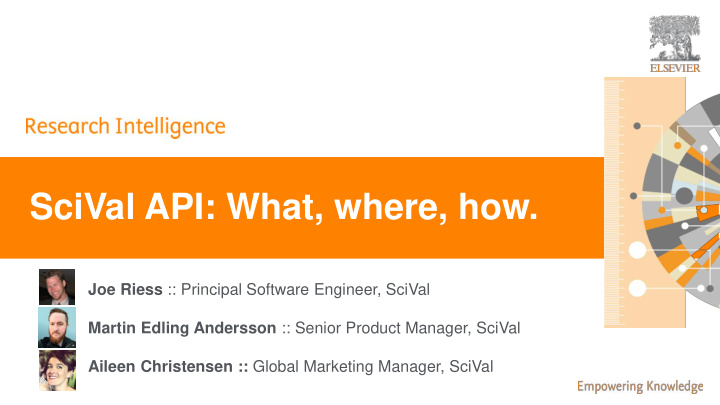



| 0 SciVal API: What, where, how. Joe Riess :: Principal Software Engineer, SciVal Martin Edling Andersson :: Senior Product Manager, SciVal Aileen Christensen :: Global Marketing Manager, SciVal
| 1 Today’s agenda • Background – Why a SciVal API? • What is an API and how does an API work • Differences an API and SciVal.com • Use cases • Scope of first release (and what’s not in Scope) • The Scopus API • Bringing it all together • Timelines • Question/Feedback
| 2 SciVal API Why use an API? Primary: Need to use SciVal metrics to feed internal warehouse - systems, CRIS systems like Pure* and reporting systems like Tableau. Secondary : To help research administration and planning office by - pushing university organizational structure from central location to SciVal. How? The API will allow you to use the most popular metrics from SciVal on - researchers and institutions for use in IR systems, web, and for richer visualizations in tools like Tableau.
| 3 User research findings: SciVal API use cases I want to evaluate Peter I want to conduct Create department of Andersen at the analysis of research Chemistry in SciVal University of Bergen performance using based on the structure based on his FWCI Tableau because I want and researchers that I together with his to do more advanced have in our Institutional teaching commitments visualizations and use Repository. and other projects. data from different sources.
| 4 First, let’s take a step back - what is an API? • API = Application Programming Interface • A way (interface) for programs (application) to talk to one another. • As comparison: A GUI (Graphical User Interface) is used by humans to talk to programs. REQUEST USER’S API APPLICATION DATA
| 5 Example of how an API works Can I have the Hey Sure! It’s It ’s me – API key FWCI for author {"metric": { I know SciVal! id # 35448793100 456789 "value": 1.214434, Hello! 1.21 you! "metricType": "FieldWeightedCitationImpact" for 2012 - 2016? } } www User’s application https://api.elsevier.com/metrics/ FieldWeightedCitationImpact ? apiKey =456789& htt pAccept =application%2Fjson& authors =35448793100& yearRange =5yrs&includeSelfCitat ions=true& byYear =false& includedDocs =AllPublicationTypes& journalImpactType =Cite Score& showAsFieldWeighted =false& indexType =hIndex
| 6 An API is just another content delivery mechanism SciVal.com SciVal API Download SciVal Download the most metrics from common metrics anywhere in the for institutions and application using researchers the Export function Characteristics Characteristics Allows for Download anything automation of available but labor repetitive tasks. intensive for Requires some repetitive work. technical knowledge
| 7 What is the Scope of the API? • Retrieve metrics on researchers (author profiles) and institutions Scholarly Output 1. Publications in Top Journal Percentiles 2. Outputs in Top Citation Percentiles 3. Field-Weighted Citation Impact (FWCI) 4. Collaboration 5. (86% of all metric calls) Citation Count 6. Citations Per Publication (CPP) 7. h-indeces 8. Collaboration Impact 9. Cited Publications 10. • All metrics options included • Data for the last 5 years (rolling window) • Initial limitation of 2000 metric requests per month per user • 100 ids can be queried in one request.
| 8 What are we going to be adding later • Metrics on Publication sets , Groups of Researchers , Groups of Institutions , Countries and Groups of Countries . • Metrics on your “own” entities (API access is not yet tied to My SciVal) • Integration with 3 rd party commercial CRIS systems - but it is something we are working on.
| 9 Access through Elsevier Developers • Delivered through Elsevier Developers together with Scopus, SD, Embase and EV APIs (dev.elsevier.com). • The Elsevier Developers provides: API key generation (for - authentication) API service agreement (must - be signed for API access) Use Policies - Use cases - Interactive documentation -
| 10 What about the Scopus API? SciVal API Use Cases (beyond 1 st release) Simple Scopus API Use Cases Showing SciVal metrics for authors on your website Showing publications from Scopus on your website Showing SciVal metrics for institutions on your Showing Scopus cited-by counts on your website website Analyzing SciVal data in external visualization tool Federated search (Tableau, plot.ly, etc.) Showing SNIP/SJR/CS on journal homepage Populating IRs with basic document metadata from Populating IRs with author and institutional metics Scopus from SciVal Populating CRIS with document and citation Populating CRIS with with author and institutional from SciVal overviews from Scopus Future: Using hierarchical structures in SciVal from Complex Populating publication histories of VIVO profiles CRIS
| 11 Demo.
| 12 Source code available at: https://github.com/ElsevierDev/apidemo
| 13 What about Pure? • Pure already has good integration with SciVal Researchers and documents can be sent to SciVal for analysis - Groups of Researchers can be sent to SciVal. - SciVal can enrich Pure data with Scopus Author IDs. - • We will continue to work with the Pure team for future functionality. • 2018 - Organizational structures (including hierarchical data) can be sent to SciVal
| 14 Timelines • 2017 – First release - retrieve metrics through Elsevier Developer Portal Analyzing institutions and researchers: - o The FWCI of University of Bath for 2010 to 2015 o The Scholarly Output for Sven Andersson at University of Lund in 2016. Documentation in Swagger* format - Examples based on use cases. - • 2018 - Keep soliciting feedback Support for more entities such as Researchers, Groups of Researchers, Countries and Groups of Countries. - Support for your entities (“My SciVal”) - Integration with 3 rd party CRIS vendors - What are practical ways of working with organizational structures using the API? - Other undiscovered use cases? - *Swagger/Open API specification – industry standard documentation format for RESTful Web Services
| 15 Join the Conversation SciVal Twitter Twitter.com/scival SciVal Facebook Facebook.com/scival Research Intelligence YouTube Youtube.com/channel/UCffqIj7ICiYccxNDPEEjHHg Research Intelligence LinkedIn Linkedin.com/showcase/10576088 Research Intelligence BrightTALK Brighttalk.com/channel/13819/elseviers-research-intelligence
| 16 Questions/Feedback?
| 17 Thank you! Stay up to date: don’t forget to follow @ SciVal on Twitter www.elsevier.com/research-intelligence
Recommend
More recommend